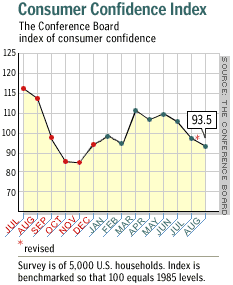NEW YORK (CNN/Money) -
Are disappointing August retail sales no big deal or a harbinger of a dangerous slide in consumer spending?
Wal-Mart (WMT: Research, Estimates), Target (TGT: Research, Estimates) and other chain retailers said Thursday that same-store sales -- a key indicator of retail activity -- fell short of their expectations in August.
Some economists believe the weakness was mainly the result of strong automobile sales "stealing" strength from other sectors. Others worry it could be a sign that U.S. consumers are finally exhausted after carrying the economy through a recession, terror attacks, falling stocks and more.
It will take time to sort out which camp is right.
Reasons not to worry about retail sales
For one thing, auto sales zoomed in August, driven by the same kind of aggressive dealer incentives, such as zero-percent financing, that boosted consumer spending after the Sept. 11 terror attacks.

"Consumers have proven many times over that when they can get something at a good value, they'll do it," said Robert MacIntosh, chief economist at Eaton Vance Management.
And people are still relentlessly buying houses, spurred by mortgage rates that hit a new bottom practically every week and keep drilling ever downward.
Such spending behavior is hardly indicative of squeamish consumers.
"It takes a lot of confidence to buy cars and homes; people don't make that kind of decision on a whim," said Salomon Smith Barney economist Steven Wieting.
Wieting said auto sales were so strong, they could push the growth rate of consumer spending in the third quarter to 4.4 percent, compared with 1.9 percent in the second quarter.
Such growth would give a huge boost to overall gross domestic product (GDP), the broadest measure of economic strength, since consumer spending makes up about two-thirds of total GDP.
And retail sales are finicky anyway, subject to the vagaries of weather, fashion and other seasonal factors.
"My [16-year-old] granddaughter wants to see what everybody else is wearing, so her back-to-school buying will be done in September," said Delos Smith, economist at the Conference Board, which publishes a closely watched monthly study of consumer confidence. "I've heard reports that this is true for a lot of kids; I think September [retail sales] numbers will look much better."
Reasons to worry about retail sales
But retail sales were less than robust in July, too, indicating that a trend might be developing.
Bear Stearns retail analyst Dana Telsey put together a weighted average of several chains' same-store sales and found they grew just 2.1 percent in August -- the worst month since September 2001, when consumers stayed home for weeks, glued to their televisions sets in the wake of Sept. 11.

And the weighted average grew just 3.0 percent in July. Together, July and August mark the worst back-to-back months for retail sales since February and March 2001 -- when a recession began.
"The consumer is finally winding down," said Brown Brothers Harriman economist Lara Rhame, a former Federal Reserve economist. "We've seen income growth slow somewhat, and we have enough headwinds building that we can make a strong case for spending slowing markedly."
Total personal incomes were flat in July, according to Commerce Department data, while wages and salaries actually declined.
One factor keeping wages lower is the continuing weakness in the labor market. Layoff announcements jumped 46 percent in August, and weekly jobless claims were above the benchmark 400,000 level for two straight weeks at the end of August.
The Labor Department is scheduled to report on August unemployment on Friday, and economists, on average, expect the unemployment rate to remain at 5.9 percent and only 30,000 new jobs to be created.
| |
 Related links
Related links
| |
| | |
| | |
|
While 5.9 percent unemployment is low compared with the 7.8 percent rate after the 1990-91 recession and the 10.8 percent rate following the 1982 recession, slow job growth means there's less need for employers to try to raise wages to retain workers.
"Firms can't afford to offer much, and workers don't want to threaten to leave because of the job situation," said John Silvia, chief economist at Wachovia Securities.
The labor market, turmoil in the stock market and concerns about a potential military action in Iraq at some point in the near future have also weighed on closely watched measures of consumer confidence, including the University of Michigan sentiment index and the Conference Board's confidence index.
While these measures are still higher than they have been following other downturns, it could take months to clear away the factors that are weighing on them.
Though most economists doubt consumer spending will fall enough to send the economy "double dipping" back into recession, consumers seem unlikely to keep bearing the full weight of the economy, as they did in the fourth quarter of 2001, when 6 percent consumer spending growth essentially ended the recession.
"We have a situation where the baton of economic growth needs to pass from consumers to businesses, but that hasn't happened yet," said Sung Won Sohn, chief economist at Wells Fargo & Co.

|

